Photographs: Lakshmi Sharath Lakshmi Sharath
Khajuraho isn't just about erotic sculptures as Lakshmi Sharath who travelled there found out.
It is in the soft crimson light of the setting sun that I grasp the true meaning of sensuality. Lost in a world of caresses with passions running high are millions of exquisite sculptures carved on the walls of the temples in Khajuraho. They may be cast in stone but their emotions bring them alive.
Love alternates with lust as these amorous men and women are etched in a montage of erotic art.
They seem unabashed as they make no attempt to cloak their feelings. Some are locked in a tight embrace, others gaze lovingly into each other's eyes, while the rest are enacting various scenes out of the Kamasutra. And even in those private moments made public, they seem to have eyes only for their beloved.
But it is not just the erotic art that lends a touch of sensuality to Khajuraho. Besides they form barely one tenth of the entire lot of sculptures adorning the walls of the temples here.
Tall towers almost touching the sky, lit up by the evening light glow as the birds call out to each other. It is a riot of colours as the redness of the sandstone stands out amidst the blue sky and the green grass, taking you into a different world.
IN PICS: The STUNNING temples of Khajuraho!
Image: The Chausath Yogini templePhotographs: Lakshmi Sharath
I head to the oldest temple in this town -- the Chausath Yogini temple built in 900 AD. In an open sanctuary located on a mount are sixty seven cells silhouetted against the setting sun. The shrines, made of granite are however empty. None of the 64 Yogini along with Goddess Durga are around, but I can feel a mystical aura around the mount.
Mamaji my guide believes that the essence of Khajuraho lies in tantric cult and the erotic sculptures are manifestation of the same. The locals however say that the underlying thought is to leave your lust behind before entering the temple, which is probably why these sculptures do not show the Gods and goddesses in intimate moments.
I for one love legends and I fall for this one. There is always something romantic about the moon and it is little wonder that the descendants of the celestial moon God would build monuments that stand for love.
The story goes that a beautiful woman called Hemavathy was bathing in the dark under moonlight, when she was seduced by the moon himself. She ran into the forests for refuge and raised her son, Chandravarman alone. The moon however promised her that their son would one day rule over a kingdom.
True to his word, Chandravarman grew up to establish the Chandela dynasty. It is believed that he was influenced by his mother's story and so he built temples with sculptures depicting human passions and probably, the futility of the same.
Whatever the reason may be, Khajuraho's temples go beyond the Kamasutra. Located on the banks of a tributary of the Ken river, these medieval monuments are today one of the World Heritage Sites. Built between the 10th and 12th centuries by the Chandela Rajputs, these temples hidden amidst forests were not fully explored until the 19th century. Dedicated to deities and their various cults, these shrines go beyond religion and history.
IN PICS: The STUNNING temples of Khajuraho!
Image: The Kandariya Mahadev templePhotographs: Lakshmi Sharath
The Western Group of temples are the largest here and then you have the Eastern and the Southern Group and a few Jaina monuments as well. Mamaji says that there were more than 85 temples here at one time, today however you get to see about 22 of them. One wonders why this town named after date palms would be chosen by Chandelas as their cultural capital.
Walking around Khajuraho, I almost feel like I am entering a medieval world of apsaras and deities, mortals and devils. The Kandariya Mahadev temple towers above the rest in the Western Group with almost 900 sculptures jostling for space on its walls, both interior and exterior. Representing Kailash, the temple gives an illusion of a mountain range, as the main tower, almost 30 metres tall, is surrounded by several miniature towers resembling smaller peaks.
You see sculptures depicting Gods and Goddesses, animals and birds, artists and soldiers and you cannot miss some of the most passionate erotic carvings here. Dedicated to Shiva, the temple is believed to have built by King Vidhyadhara after a successful war campaign.
IN PICS: The STUNNING temples of Khajuraho!
Image: The Lakshmana temple dedicated to VishnuPhotographs: Lakshmi Sharath
You can spend almost an entire day here at Khajuraho. The Lakshmana temple dedicated to Vishnu built by Yashovarman is one of my personal favourites. The Vaikunta image of Vishnu is portrayed as a composite of three faces -- those of a lion, boar and a man. Sculptures fill the walls here as well, as you lose yourself in the everyday life of the Chandelas of the medieval period.
Facing this temple is a Lakshmi temple, that once housed a Garuda and next to it is an intricately carved monolith of Varaha, the incarnation of Vishnu built of sandstone. More monuments surround the complex. Along the same platform of the Kandariya Mahadev temple is a Mahadev temple, another shrine dedicated to Jagadhambi, a Chitragupt temple for Surya, the sun god, a shrine for Parvati and the massive Vishwanath temple.
IN PICS: The STUNNING temples of Khajuraho!
Image: The Bramha temple is a a small shrine that overlooks a lakePhotographs: Lakshmi Sharath
We move on to the Eastern and Southern group and stop by at a small Durga temple, where the image of the deity was believed to have been discovered during an excavation. Driving around Khajuraho, you realise that it is just a small village, quiet and spotlessly clean.
The locals however seem oblivious to the heritage surrounding them, except for the vendors who try to cash in on the 'erotic' imagery and sell crude representations of the sculptures. More than guide books, the Kamasutra is sold locally in front of every temple. I stop by the Brahma temple, a small shrine that overlooks a lake. Although a lingam is housed here, it was initially meant to be built for Vishnu.
IN PICS: The STUNNING temples of Khajuraho!
Image: The Chathurbhuj templeThe local names of the temples here are fascinating. Mamaji takes us to a Vishnu temple called Javari temple, after millet or Javar that was growing in fields nearby and a temple, called Ghantai, takes its name from the imagery of bells and chain on its pillars.
My final stop is the Southern end and we first stop at a few Jaina temples that take your breath away. Dedicated to the Teerthankaras -- Adinatha, Parshwanatha and Shantinatha, the shrines are in a different landscape, surrounded by trees and sculptures.
It is difficult to tear yourself away but we move on to the Chathurbhuj temple to see the last rays of sun falling on the feet of a charming idol of the four armed Vishnu. Finally as the sun almost calls it a day, I visit one of my favourite temples, probably the last built by the Chandelas.
The Dulhadeo temple, where Shiva is a bridegroom is a temple dedicated to weddings, fertility rites and cults. A quaint and a quiet monument, it clearly shows a departure from the earlier style of the shrines built around this town.
IN PICS: The STUNNING temples of Khajuraho!
Photographs: Lakshmi Sharath
Back at the hotel, the Lalit Khajuraho we watch the moon rise from a clear sky. There is magic in the air. Suddenly the lights come up at the horizon as the monuments are lit and a soft voice narrates the story of Hemavathy and her tryst with the moon God and the tale is told all over again.

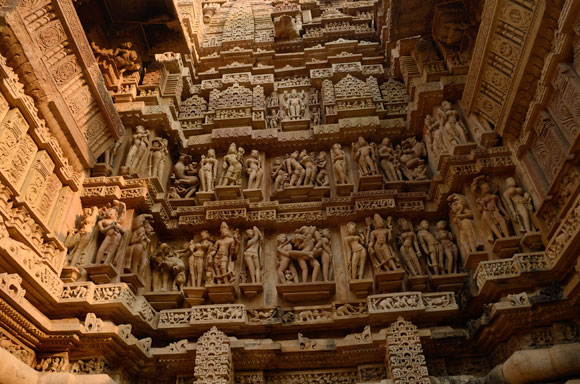
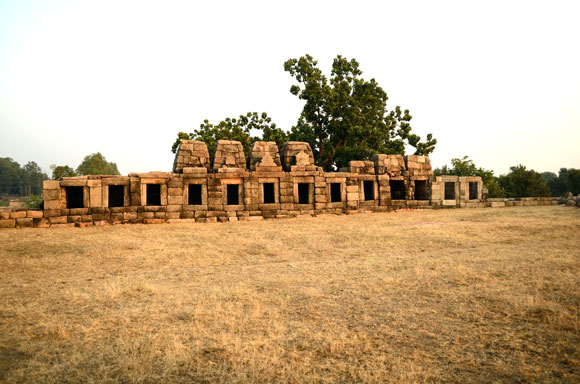
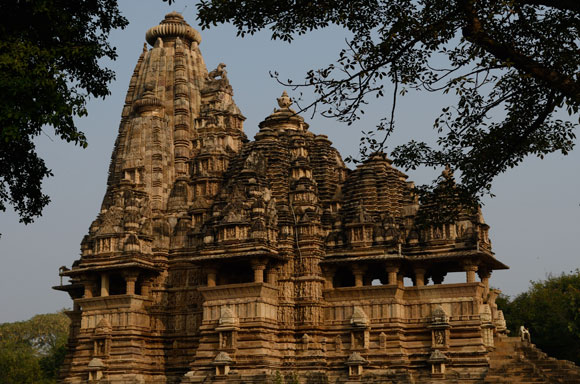
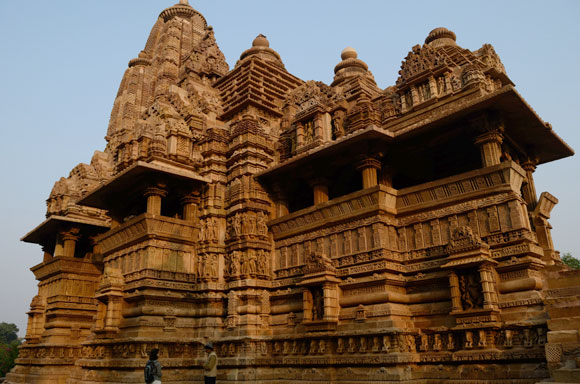


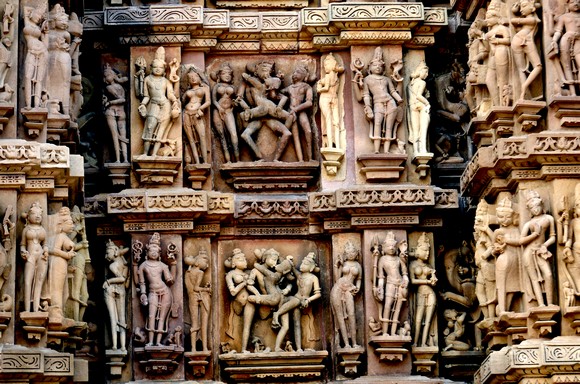
Comment
article